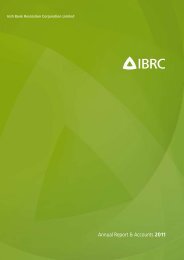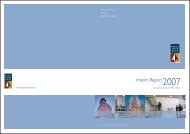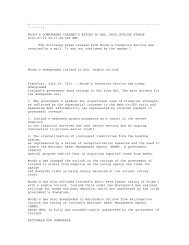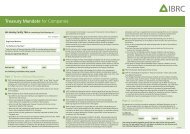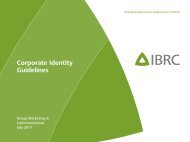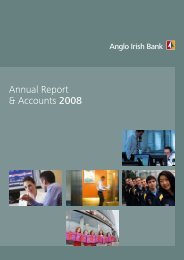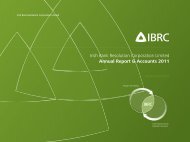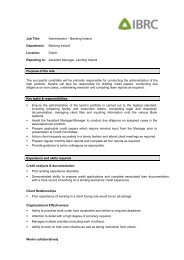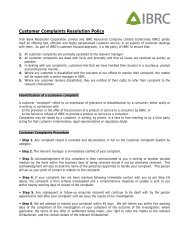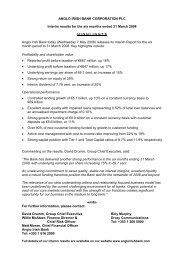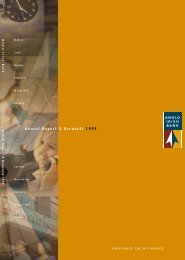Annual Report & Accounts 2009 - Anglo Irish Bank
Annual Report & Accounts 2009 - Anglo Irish Bank
Annual Report & Accounts 2009 - Anglo Irish Bank
You also want an ePaper? Increase the reach of your titles
YUMPU automatically turns print PDFs into web optimized ePapers that Google loves.
Business review continued<br />
Capital<br />
Losses incurred by the <strong>Bank</strong> during the period to<br />
31 December <strong>2009</strong> resulted in a significant deterioration<br />
in the <strong>Bank</strong>’s regulatory capital base. The €8.3 billion<br />
capital contribution from the <strong>Bank</strong>'s Shareholder as at<br />
31 December <strong>2009</strong> was included in the <strong>Bank</strong>’s regulatory<br />
capital resources at that date. The inclusion of this capital<br />
contribution, which was approved by the Financial Regulator,<br />
restored the <strong>Bank</strong>'s regulatory capital position resulting in a<br />
Tier 1 Capital ratio of 6.6% and a Total Capital ratio of 10.7%<br />
as at 31 December <strong>2009</strong>.<br />
On 31 March 2010, the €8.3 billion due from the Shareholder<br />
at year end was settled via receipt of a promissory note. The<br />
principal amount of the note is €8.3 billion and is adjustable<br />
allowing for the <strong>Bank</strong> to continue to meet its regulatory<br />
capital requirements. Note 58 to the <strong>Annual</strong> <strong>Report</strong> provides<br />
further details on the promissory note.<br />
The <strong>Bank</strong> reported a total capital ratio of 7.8% as at<br />
31 May <strong>2009</strong> in its regulatory returns, a breach of the<br />
minimum requirement at that reporting date. This breach was<br />
temporary as the Minister for Finance, following his<br />
commitment made on 28 May <strong>2009</strong>, invested €3 billion of<br />
share capital on 29 June <strong>2009</strong>, restoring the <strong>Bank</strong>’s Total<br />
Capital ratio to above the minimum required. The Minister for<br />
Finance invested a further €1 billion of share capital in two<br />
subsequent tranches: €0.8 billion on 6 August <strong>2009</strong> and<br />
€0.2 billion on 25 September <strong>2009</strong>. The €0.8 billion<br />
investment was made following the completion of the LME<br />
undertaken by the <strong>Bank</strong> on 4 August <strong>2009</strong> where €1.8 billion<br />
of equity was realised on the buyback of subordinated debt<br />
instruments. Further details of the LME are provided in notes<br />
7 and 42 to the <strong>Annual</strong> <strong>Report</strong>.<br />
The <strong>Bank</strong>’s regulatory capital position during the period to<br />
31 December <strong>2009</strong> has benefited from derogations from<br />
certain regulatory capital requirements which were granted on<br />
a temporary basis by the Financial Regulator following<br />
requests from the <strong>Bank</strong>. These derogations have been granted<br />
in five tranches and full details of all derogations granted are<br />
disclosed in note 53 to the <strong>Annual</strong> <strong>Report</strong>. The latest<br />
derogations are applicable until 30 April 2010 or such<br />
shorter period if the <strong>Bank</strong>’s capital ratios are restored to<br />
a level adequate to enable it to comply with its existing<br />
capital ratio requirements in place prior to the granting of<br />
these derogations.<br />
16<br />
The capital investments and capital contribution made<br />
to date by the Minister for Finance are evidence of the<br />
Shareholder’s stated commitment to ensuring that the <strong>Bank</strong><br />
remains adequately capitalised. As indicated in note 24 to the<br />
<strong>Annual</strong> <strong>Report</strong>, the <strong>Bank</strong> expects to transfer €35.6 billion of<br />
loans (gross of specific impairment charges) to NAMA during<br />
2010. While the final determined transfer price may trigger<br />
additional losses and further capital requirements in the short<br />
term, these transfers will significantly reduce the level of risk<br />
weighted assets, easing pressure on the <strong>Bank</strong>’s overall capital<br />
requirement going forward.<br />
The Chairman’s statement and the Group Chief Executive’s<br />
review contain details on how the <strong>Bank</strong> aims to manage its<br />
capital base going forward. In addition, note 53 to the<br />
<strong>Annual</strong> <strong>Report</strong> provides details on the <strong>Bank</strong>’s regulatory<br />
capital position as at 31 December <strong>2009</strong>.<br />
Private <strong>Bank</strong>ing<br />
The Group’s Private <strong>Bank</strong>ing business operated against a<br />
backdrop of poor economic conditions and depressed asset<br />
markets throughout the period under review. Income in the<br />
period mainly comprised recurring interest and fee income<br />
with minimal structuring and set up fees in the absence of<br />
new business. Recurring asset under management fees were<br />
lower as a result of declines in the value of client assets under<br />
management. Asset management and related fees have<br />
declined by €13 million from 2008.<br />
Trust and fiduciary fees are earned where the <strong>Bank</strong> provides<br />
custody, trustee, investment management and advisory<br />
services to third parties, but where the related assets are not<br />
carried on the Group's balance sheet. Following the sale of<br />
the Austrian private banking business in December 2008 these<br />
activities no longer represent a significant revenue stream for<br />
the Private <strong>Bank</strong>ing business. The Group realised a profit of<br />
€49 million from this sale which saw the <strong>Bank</strong> provide the<br />
purchaser with a €24 million long term subordinated loan to<br />
part fund the purchase price of €141 million.<br />
As part of normal business activity the <strong>Bank</strong> previously<br />
acquired property assets with the intention of placing these<br />
investments with Private <strong>Bank</strong>ing clients. However, due<br />
to wider market conditions a lack of investor appetite has<br />
resulted in these assets now being held on the Group’s<br />
balance sheet. Depending on the investment structure used



